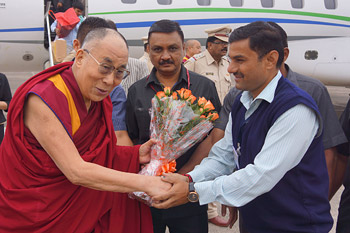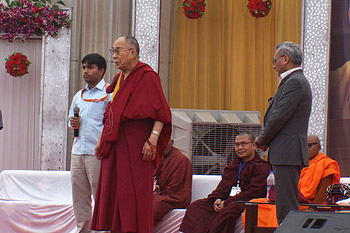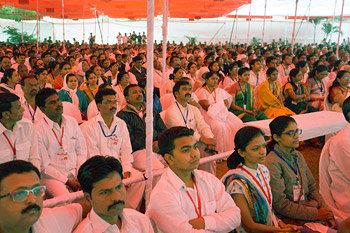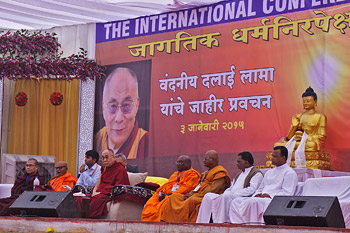His Holiness the Dalai Lama Leaves Surat and Travels to Nashik
Nashik, Maharashtra, India, 3 January 2015 - Prior to His Holiness the Dalai Lama’s departure, his host Mr Govind Dholakia came with his family to thank him once more for coming to Surat. His Holiness thanked him in turn and encouraged him to keep up his good work, his philanthropy as well as his business. 
| Members of the Indo-Tibetan Mangal Maitri Sangh welcoming His Holiness the Dalai Lama on his arrival at the airport in Nashik, Maharashtra, India on January 3, 2015.
Photo/Jeremy Russell/OHHDL
|
There was some turbulence on the flight from Surat and on arrival at Nashik the weather was unexpectedly misty and overcast. Having been received at the airport by representatives of the Indo-Tibetan Mangal Maitri Sangh, His Holiness drove into the city where a gathering, estimated to number more than 4500, Tibetans and Indians, waited patiently to hear him. He joined Burmese, Indian and Sri Lankan Buddhist monks and Christian priests on the stage and began by asking for a show of hands to see how many listeners needed a Hindi translation, which was about half the audience. Dispensing with further formality he began:
“Brothers and sisters I am here again because some of you have invited me. I am very happy to be with you once more. I can see the organizers have put a lot of work into making the arrangements and I’m grateful. Wherever I speak I think about how we are all the same as human being, all 7 billion of us. We all have the potential to good and to do harm, so our important task, if we want to live a happy life, is to reduce the negative and increase the positive in what we do.
“Wherever I go, I keep two commitments in mind. The first, as a human being, is to spread awareness of the most effective way to achieve a happy life, which is to put basic human values, inner values, into practice. Secondly, as a Buddhist monk, I am eager to promote inter-religious harmony. I am happy to see Buddhists, Christians and Hindus here, are there no Muslims? Religious harmony is important because all the major religious traditions are supposed to bring inner peace, but too often they are used to foster anger and hatred. We are all at peace here, but in other parts of the world conflict and violence have broken out in the name of religion - this is why we have to make an effort to create harmony between us. “
His Holiness observed that all sentient beings, animals and insects included, who experience pleasure and pain, seek happiness. All 7 billion human beings want to live a happy life and every one of us has a right to do so. He noted that besides the sensory experience we have in common with animals, we human beings also have highly developed brains that are able to conjure up visions of the future as well as powerful memories of the past. In one way this is wonderful because it gives us the ability to solve problems, but in another it also allows us to become ensnared in worry about the future and regret for the past.

| His Holiness the Dalai Lama speaking during his talk on "Secular Ethics" in Nashik, Maharashtra, India on January 3, 2015. Photo/Jeremy Russell/OHHDL
|
Because our human intelligence allows us, in addition to enjoying sensory experience, to overcome difficulties and lead a happy life, that is what His Holiness suggested we focus on. We need to pay attention to developing and maintaining peace of mind. “When we are hungry,” His Holiness remarked, “prayer and meditation won’t fill our stomachs, that’s why these monks have to go on their alms round. But if we compare our physical pleasure and pain with our mental experience, the mental is much more powerful. Having a calm mind we can withstand or overcome physical pain, but physical comfort alone will not relieve mental unease. I have wealthy friends who have all they could want, but because they worry, they are unhappy. This shows that material comfort is not enough by itself to make us happy. Scientists have found that anger, fear and hatred damage our immune system, while peace of mind fosters good health. Does our modern materialistic society by itself provide for a peaceful, happy humanity? I don’t think so. What we also need to do is pay attention to the inner values that give rise to peace of mind.
“We all experience these inner values, love, affection, trust and so on, in the arms of our mother as soon as we are born. According to some scientists the mother’s touch is the major factor encouraging the proper growth of our brains in those first early days of our lives. Those of us who receive such affection when we are young tend to feel happy and secure later in life too, whereas those who, for some reason, lack it, tend to be insecure and have difficulty trusting others. This can be a source of frustration because our very life depends on the rest of our community.
“When we are children we don’t care very much about differences of faith, family or nationality, we just play together. But as we grow up we function less on that basic human level and learn to pay more attention to secondary differences like faith, race, social background and level of education. By seeing each other in terms of ‘us’ and ‘them’, we lay the ground for conflict. We seek ways for ‘us’ to win and ‘them’ to lose. This is the basis for bullying, cheating and exploitation that gives rise to violence, corruption and the gap between rich and poor. It is a result of thinking only of yourself, with no regard for others. The time has come to promote the oneness of humanity instead.”

| Some of the over 4,500 people attending His Holiness the Dalai Lama's talk in Nashik, Maharashtra, India on January 3, 2015. Photo/Jeremy Russell/OHHDL
|
His Holiness said that among religious people there are those who believe in god and his creation and those who don’t. However, all these traditions carry a message of love, supported by the need for tolerance, forgiveness, simplicity, contentment and self-discipline. Because they all have this in common, he said, the religious should see each other really as spiritual brothers and sisters. However, despite this, no one religious tradition, no matter how wonderful, will satisfy everyone.
Of the world’s 7 billion population, 1 billion claim to be non-believers. His Holiness said that if we approach them about ethics on the basis of religion, they are likely to reject it. Even among so-called believers there are many who are not really sincere, over whom religious values have little sway. It is in this context that His Holiness feels there is hope for secularism, a tradition that has persisted for several thousand years in India, which views all religions and even the views of non-believers with respect.
“Since the 20th century was an era of bloodshed,” His Holiness observed, “because there will always be a potential for conflict, we need to find solutions rooted in dialogue and a spirit of reconciliation.”
Smiling at the Buddhist monks belonging to different traditions seated with him, His Holiness explained that even within Buddhism there are different views. He said we might ask why what the Buddha taught at one time or in one place seems to contradict what he taught at another time or place.
“Was he confused? No. Was he trying to confuse others? No. It’s because people have different dispositions and he would teach them accordingly. From this we can also understand the value of there being a variety of religious traditions to meet people’s different needs. Whatever the case may be, I have met excellent people from all our religious traditions, whose faith is a source of inspiration and who are dedicated to the welfare of others.’
His Holiness invited members of the audience to ask questions and, if they liked, to argue with him. But before that began, representatives of the Nashik Municipal Corporation took the opportunity to welcome him to their city, saying that they felt privileged to have him among them once more.

| His Holiness the Dalai Lama answering questions from the audience during his talk in Nashik, Maharashtra, India on January 3, 2015. Photo/Jeremy Russell/OHHDL
|
Asked who or what is responsible for the evolution of religion, His Holiness replied that it depends on your philosophical point of view. According to those who believe in God, he is responsible. Others may think it is something that evolves among human beings. Another questioner wanted to know how to introduce ethical values into the education system and His Holiness assured him that work is going on to develop a curriculum that will enable the teaching of secular ethics in a secular education system. Universities in Delhi, the USA and Europe are taking part. He told a young woman who was concerned that many of her generation have lost interest in religion but still need a common platform on which to base their values that he envisages secular ethics being able to do just that.
“Secular ethics can appeal to everybody, because they are in everyone’s interest.”
A more philosophical question drew the answer that what we have to deal with is the gap between appearance and reality. The Buddha taught that there is a self, but it doesn’t exist the way it appears as an independent entity. It only exists as a designation on the basis of the body and mind. Asked whether the good governance of the Ashokan empire had anything to teach us today, His Holiness replied that unfortunately in modern India there is little appreciation of ancient India’s rich and profound knowledge. He advised that if the essence of that knowledge can be combined with modern development, India will not only be happier, it will serve as an example to the world.
Suddenly, everyone stopped to listen as the small voice of a young girl asked: “How do you become a Buddha? And what does it feel like to be a Buddha?” His Holiness asked her how old she was and she told him, “Six.” He laughed saying he’d never have asked such a question at that age. He told her you become a Buddha by transforming the mind. And you need to use your intelligence. The important thing is to keep at it. He told her that if she were to learn how to transform her mind, by the time she’s 16, she’ll understand better how to do it. When she’s 26 she’ll know much more. When she’s 36, she’ll have gained a lot of experience. This is how to go about it. As to what it feels like to be a Buddha, His Holiness told her she’d have to ask Buddha Shakyamuni.
When another member of the audience asked if it is possible to attain enlightenment in one life, His Holiness responded that some texts say you can, but he has his doubts. He said:
“When I was younger I used to try to grow flowers. I would plant the seeds and then water them and try to encourage them to grow quicker. It didn’t work, things like that take their own time. Transforming the mind takes its own time too. There are three levels of knowledge, what we learn from reading or listening to explanations which is quite rough and shallow. Then there’s what we understand as a result of analysing what we’ve read or heard, which is deeper and more stable. Finally, there is what we know as a result of prolonged and focussed familiarity, which has the quality of experience. We can apply this approach to the Two Truths, the Four Noble Truths and the Eightfold Noble Path. In my experience, if you keep it up for 5 or 6 decades you should have something to show at the end.”
His Holiness was to meet local Buddhists in the afternoon and to return to Delhi tomorrow. http://www.dalailama.com/
|